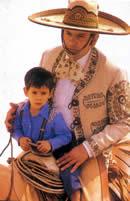The Mexican Charro Suit, A Uniform of Tradition
The Charro represents the tradition and natural evolution of the charrería art with all the dexterity and the most important element: an identity perfectly defined of the Mexican as a self-assured man, calm and proud of his ancestral roots.
The Indian and the mestizo indulged in creating with a genuine art, the Charro suit until achieving designs and styles which pleased the taste of that period, always in tune with the conditions imposed by the latitudes, climates and the orography of the country.
With fibers prepared by them and wool, they made serapes, jorongos and pants; jackets, pants and leather pantaloneras. They wore clothes made by women combined with different hats and as tackles they made their own bows and complements of the saddle.
THE ONSET OF THE CHARRO
Mexicans are the result of a solid cultural heritage with well-defined qualities and an undoubtedly and necessary identity.
The most remote origin of the Charro suit is found in colonial times; however, its major significance was observed in the 19th century, when the Indian peasants add to their shirt and pants, the most attractive elements of the outfits of their masters: the Spaniards. Though, on the one hand, it is believed it was just the evolution of the peasant suit of Salamanca (named Charro) since it shows deeply enrooted items as the use of the hat and boots, determined by the influence of the horsemen from Navarra and the Andalusians of that period.
The conquerors brought horses to Mexico and with them, the enthusiasm for competitions among horsemen and bullfights. These traditions were inherited by Creoles and mestizos. Riding beautiful horses with majestic suits was the recreation of the wealthy landowners of that time.
At the beginning, the Charro suit included a very short jacket, loose pants with tapabalazos (flies of trousers); calzoneras made of cashmere (for rich ranchers) or thick suede (for caporals and mayordomos), with silver buttons at both sides and in the tapabalazos. In the lower part¾exposing the pant¾, embroidery, openwork and other delicate decorations were made. They use to wear winged shoes or suede boots. Shoes were decorated with rich embroidery and chisels elaborated by Mexican women.
A winged brim, low crown and thick shawl characterized the hat. A colorful silk band resembling a sort of belt was tied to the waist and on one shoulder, a magnificent serape (long shawls).
At present, the characteristics of those items have been completely lost because of the evolution process.
Full-gala Charro suit was worn for the first time by Archduke Maximilian of Habsburg, who also had luxurious tackles, embroidered and decorated with gold and silver, accompanied by a black jacket made of British woolen cloth.
Tradition, culture and folklore intermingle in a single suit which should be properly worn and this requires responsibility since it is an indication of the Mexican dignity.
The suits:
-Full Gala Suit: Completely black from the very hat, made of fine garment, silver buttons, bow tie either white, black or red, suede or patent leather boots, white shirt and gunbelt of the same color of the shoes. This suit is only worn in important ceremonies and it's not fit for riding.
-Gala Suit: It can be of other color rather than black, made of fine cloth, decorated with silver buttons and with the same conditions than the previous one. Worn in ceremonies, parades, parties, civil ceremonies, fit for riding, etc.
-Half-Gala Suit: It's a bit less decorated than the previous one, but abiding by the same rules for its use. It's fit for riding.
-Working Suit: It can be a full suite, but less austere or simply composed of pants, shirt, boots, pistol, a bow tie of a dark color and a strong and resistant hat. Suitable for competitions.


































































